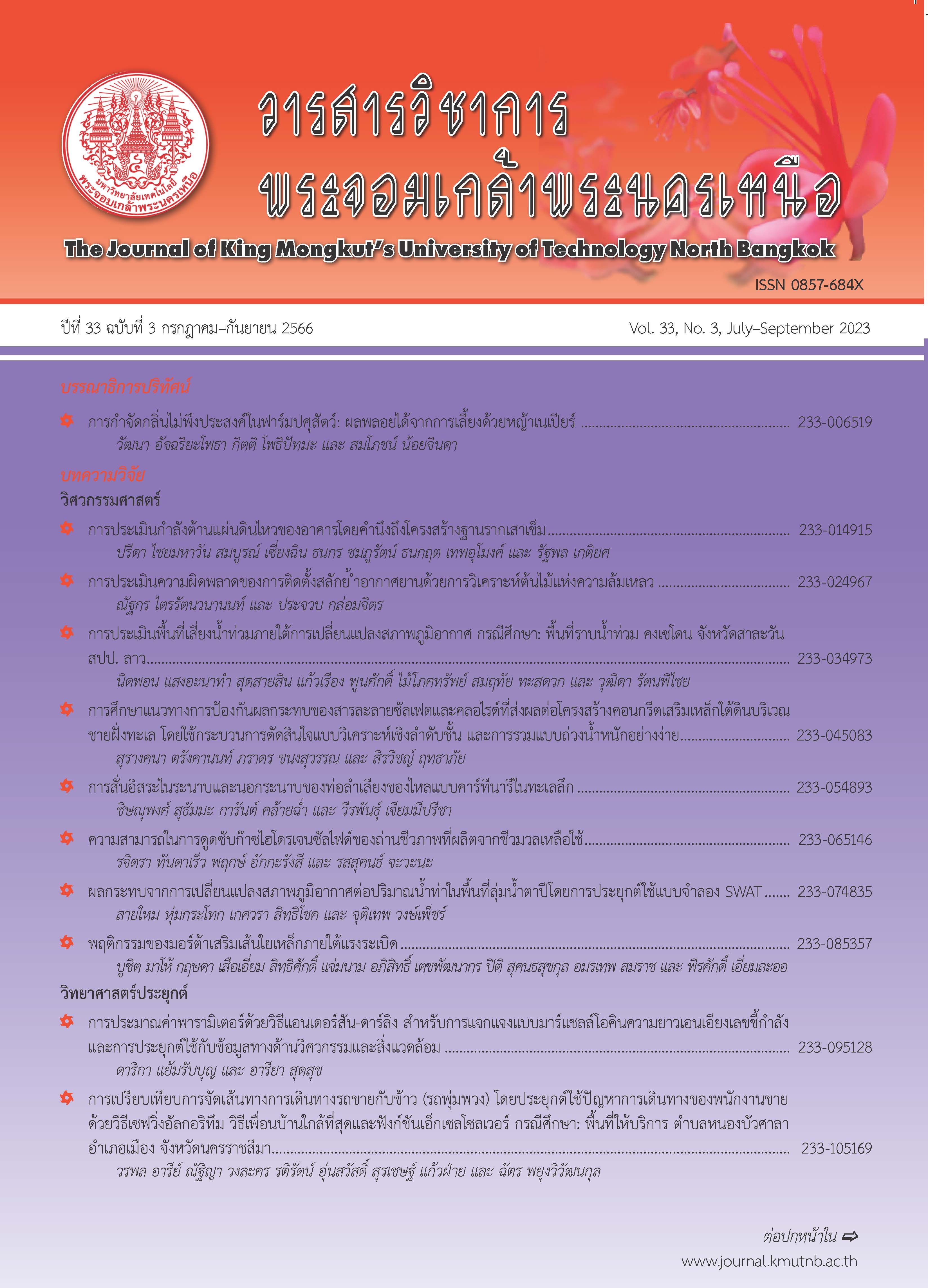ผลกระทบจากการเปลี่ยนแปลงสภาพภูมิอากาศต่อปริมาณน้ำท่าในพื้นที่ลุ่มน้ำตาปีโดยการประยุกต์ใช้แบบจำลอง SWAT
Main Article Content
บทคัดย่อ
การศึกษานี้มีวัตถุประสงค์เพื่อประยุกต์ใช้แบบจำลอง SWAT ในการศึกษาแนวโน้มการเปลี่ยนแปลงปริมาณน้ำท่า และผลกระทบจากการเปลี่ยนแปลงสภาพภูมิอากาศต่อปริมาณน้ำท่าในพื้นที่ลุ่มน้ำตาปี โดยมีการสอบเทียบและทวนสอบผลการคำนวณปริมาณน้ำท่าจากแบบจำลอง SWAT กับผลการตรวจวัดปริมาณน้ำท่าที่ 2 สถานี ได้แก่ สถานี X.36 (คลองพุมดวง; บ้านท่าขนอน อ.คีรีรัฐนิคม จ.สุราษฎร์ธานี) และสถานี X.217 (แม่น้ำตาปี; บ้านเคียนซา อ.เคียนซา จ.สุราษฎร์ธานี) ในการสอบเทียบแบบจำลองในช่วง พ.ศ. 2546–2551 ที่สถานี X.36 ได้ค่าค่าสัมประสิทธิ์สหสัมพันธ์ (R2) = 0.77 และค่า Nash-Sutcliffe efficiency; NSE = 0.93 และ PBIAS = –6.77% และที่สถานี X.217 มีค่า R2 = 0.72 ค่า NSE = 0.65 และ PBIAS = –17.59% และผลการทวนสอบแบบจำลองที่สถานี X.36 มีค่า R2 = 0.74 ค่า NSE = 0.73 และ PBIAS = 4.00% และที่สถานี X.217 มีค่า R2 = 0.76 ค่า NSE = 0.75 และ PBIAS = –9.53% ซึ่งการสอบเทียบและทวนสอบแบบจำลอง SWAT อยู่ในเกณฑ์ที่ยอมรับได้ และจากการศึกษาแนวโน้มการเปลี่ยนแปลงปริมาณน้ำท่าในช่วงอดีต 20 ปี (พ.ศ. 2541–2560) พบว่า ลุ่มน้ำตาปีมีปริมาณน้ำท่าเฉลี่ย 14,634.28 ล้าน ลบ.ม./ปี มีแนวโน้มการเปลี่ยนแปลงตามความสัมพันธ์เชิงเส้นลดลง 38.048 ล้าน ลบ.ม./ปี และผลการเปลี่ยนแปลงสภาพภูมิอากาศจากการย่อส่วนแบบจำลองภูมิอากาศโลก CanESM2 ด้วยวิธีทางสถิติของข้อมูลอุตุนิยมวิทยา ได้แก่ ปริมาณน้ำฝน อุณหภูมิอากาศสูงสุด อุณหภูมิอากาศต่ำสุด และความชื้นสัมพัทธ์ในอากาศ ภายใต้สถานการณ์การเปลี่ยนแปลงภูมิอากาศโลก RCP 2.6, RCP 4.5 และ RCP 8.5 ส่งผลกระทบต่อปริมาณน้ำท่าในลุ่มน้ำตาปีในอนาคตช่วง 20 ปี (พ.ศ. 2561–2580) ใน RCP 2.6, RCP 4.5 และ RCP 8.5 มีปริมาณน้ำท่าเฉลี่ย 13,913.83, 13,168.09 และ 14,086.55 ล้าน ลบ.ม./ปี และมีแนวโน้มการเปลี่ยนแปลง –4.92, –10.02, และ –3.74 เปอร์เซ็นต์ ตามลำดับ
Article Details

อนุญาตภายใต้เงื่อนไข Creative Commons Attribution-NonCommercial-NoDerivatives 4.0 International License.
บทความที่ลงตีพิมพ์เป็นข้อคิดเห็นของผู้เขียนเท่านั้น
ผู้เขียนจะต้องเป็นผู้รับผิดชอบต่อผลทางกฎหมายใดๆ ที่อาจเกิดขึ้นจากบทความนั้น
เอกสารอ้างอิง
S. Sarawan. (2019), Climate change. The institute for the Promotion of Teaching Science and Technology (IPST). Bangkok, Thailand. [Online] (in Thai). Available: https://www.scimath.org/ article-chemistry/item/10620-climate-change
A. Limsakul, K. Boonpragob, and A. Chidthaisong, “Thailand’s First Assessment Report on Climate Change 2011,” Working group I: Scientific Basis of Climate Change, Bangkok, The Joint Graduate School of Energy and Environment (JGSEE), King Mongkut’s University of Technology Thonburi, Aug. 2011 (in Thai).
S. Koontanakulvong, P. Suttinon, P. Ruangrassamee, C. Suthidhummajit, and W. Hemsatien, “Research report on climate change impact and vulnerability assessment in selected sectors,” Chula Unisearch, Chulalongkorn University, June 2017 (in Thai).
S. Sarawan. (2018), “Climatological center,” Changes in Temperature and Rainfall over Thailand under Climate change. Meteorological Department. Bangkok, Thailand. Technical Document no. 551.577.3 - 01 – 2016, 2016.
Office of the National Water Resources, “Strategic environmental assessment to watershed area of Southern Thailand,” Area-based Approach, Bangkok, Thailand, 2017 (in Thai).
R. Srinivasan, T. S. Ramanarayanan, J. G. Arnold, and S. T. Bednarz, “Large area hydrologic modeling and assessment: Part II,” Journal of the American Water Resources Association, vol. 34, no. 1, pp. 91–101, 2007.
Hydro and Agro Informatics Institute. (2012, February). Data collection and analysis data project of 25 basins and flood drought model, Tapi River Basins [Online] (in Thai). Available: http://tiwrmdev.hii.or.th/web/ attachments/25basins/22-tapee.pdf
S. L. Neitsch, J. G. Arnold, J. R. Kiniry, and J. R. Williams, “Soil and water assessment tool, theoretical documentation: Version 2009,” USDA Agricultural Research Service and Texas A&M Blackland Research Center, Temple Texas, TR-406, 2011.
J. G. Arnold, J. R. Kiniry, R. Srinivasan, J. R. Williams, E. B. Haney and S. L. Neitsch, “Soil & Water assessment tool: Input/Output documentation. version 2012,” Texas Water Resources Institute, College Station, TR-439, 2015.
M. Winchell, R. Srinivasan, M. D. Luzio, and J. G. Arnold, “Arcswat interface for SWAT2012: User’s Guide,” Blackland Reserch and Extension center Texas. Agrilife Research, 720 East Blackland Road, Temple, Texas 76506, 2013.
Office of Research and Development for Land Mangement. (2004). Slope classification criteria for land development and soil and water conservation. Land Development Department. Bangkok, Thailand. [Online] (in Thai).Available: https://www.ldd.go.th/Web_Soil/clay.htm
K. Tumkoon, K. Sittichok, and C. Thepprasit, “Comparison of calibration techniques of swat model for estimation of reservoir inflow to Khwae Noi Bamrungdan Dam, Phitsanulok,” Journal of Science and Technology Kasetsart University, vol. 6, no. 3, pp. 41–59, 2017 (in Thai).
W. Me, J. M. Abell, and D. P. Hamilton, “Effects of hydrologic conditions on SWAT model performance and parameter sensitivity for a small, mixed land use catchment in New Zealand,” Hydrology and Earth System Sciences, vol. 19, no. 10, pp. 4127–4147, 2015.
K. C Abbaspour, “SWAT-CUP: SWAT calibration and uncertainty programs-a user manual,” Swiss Federal Institute of Aquatic Science and Technology, Zurich, Switzerland, 2015.
D. N. Moriasi, J. G. Arnold, M. W. Van Liew, R. L. Bingner, R. D. Harmel, and T. L. Veith, “Model evaluation guidelines for systematic quantification of accuracy in watershed simulations,” Transactions of the ASABE, vol. 50, no. 3, pp. 885–900, 2007.
C. Santhi, J. G. Arnold, J. R. Williams, W. A. Dugas, R. Srinivasan, and L. M. Hauck, “Validation of the SWAT model on a Large River Basin with point and nonpoint,” Journal of the American Water ResourcesAssociation, vol. 37, no. 5, pp. 1169–1188, 2001.
IPCC. (2015, March). Fifth assessment report: Climate change 2013: Synthesis report. Contact information for the IPCC Secretariat, Geneva 2, Switzerland [Online]. Available: http://www. ipcc.ch/report/ar5/wg1/
R. L. Wilby, L. E. Hay, W. J Gutowski, R. W. Arritt, E. S. Takle, Z. T. Pan, G. H. Leavesley, and M. P. Clark, “Hydrological responses to dynamically and statistically downscaled climate model output,” Geophysical Research Letters, vol. 27, no. 8, pp. 1199–1202, 2000.
G. Lenderink, A. Buishand, and W. V. Deursen, “Estimates of future discharges of the river Rhine using two scenario methodologies: Direct versus delta approach,” Hydrology and Earth System Sciences, vol. 11, no. 30, pp. 1145–1159, 2007.

